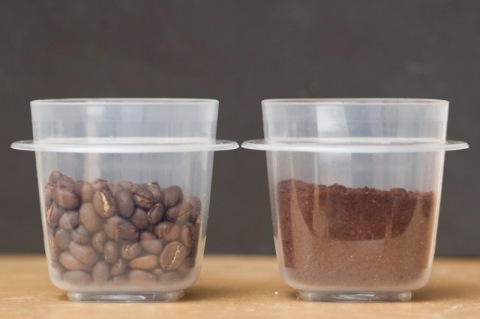Does ground coffee take up more, less, or the same volume as whole bean coffee? If I want two scoops of ground coffee, how many scoops of whole beans should I put in the grinder?
To find out, I put two scoops* of coffee beans in my blade grinder and ground it fine. After putting it into a plastic container, I gently shook it to get the coffee to settle, as it would in a package of ground coffee.
The result: pretty darn close to the same volume.
* The scoop I used is from an Aeropress, and is somewhat larger than a typical coffee scoop. According to a scale, two scoops of coffee is just under 16 grams.

When one grinds coffee beans in a market, one uses the same bag tha beans came in to collect the ground coffee.
A 1 pound bag of unground cofee is the same size as a 1 pound bag of ground coffee.
Yes! I was looking for this information. I had thought that it would actually be more, I.e., 2 tbsp unground equals 2.5 ground, as I felt more buzzed than normal this morning. Maybe I was just more buzzed on life…
This is because the space-efficiency of for instance a bunch of m&m’s is the same regardless of the size of the m&m. Think of it this way: if we have a giant jar of m&m’s it’s got some space-efficiency. Let’s say 80% of the jar is taken up by m&m’s, 20% by air. If we shrink the jar down it’s still 80% m&m because the air and the m&m’s shrank by the same amount. Whole bean coffee is like the large m&m’s, and ground coffee is like super-small m&m’s. They both have the same space efficiency (this is called the “packing fraction” if you want to do some googling).
Your investigation apparently is flawed. According to the International Coffee Organization, the densities for coffee are as follows:
Light-Roast Beans – 370 Kg/m3
Dark-Roast Beans – 290 Kg/m3
Course-Ground Coffee – 300 Kg/m3
Fine-Ground Coffee – 400 Kg/m3
The light-roast beans being relatively heavier I assume because of increased water content.
Your results are probably so close because you used such a small experimental volume. Try it with a whole pound of coffee.
And Bernard, your analogy is fallacious. We aren’t interested in the case in which both the M&Ms *AND* the air shrink. That would, of course, result in the same density. We’re interested in the case in which only the M&Ms shrink.
This echoes the OPs intuition driving this investigation. Namely, that smaller particles of the same material can pack more tightly, thus taking up less space per given mass (weight). (This is assuming that the larger particles aren’t optimally shaped, which coffee beans are not.)
Want a 2-D example? Let’s say your drilling a bunch of holes in your computer case to create a new vent that’s, say, 2″ x 4″. If you use, say, 5mm holes (spaced apart) you can fit maybe 140 holes in that area. But if you use, say, 6.5mm holes, you can only fit maybe 75 holes in that area (using the same proportional spacing as the smaller holes). If you calculate what’s called the Free-Air-Ratio of the 2 examples, you’ll see that the smaller holes give you more total “hole” area (maybe 55% versus 50% for the larger holes). That would be analagous to mass in the coffee bean experiment–smaller particles yields more stuff in a given volume.
The m&m analogy is rigorous, and so is your 2-D example. Disregarding boundary conditions, the “Free-Air-Ratio” would always be pi/4 for a square lattice of holes that are flush with one another, regardless of the hole size. Draw it up and calculate it if you don’t believe me.